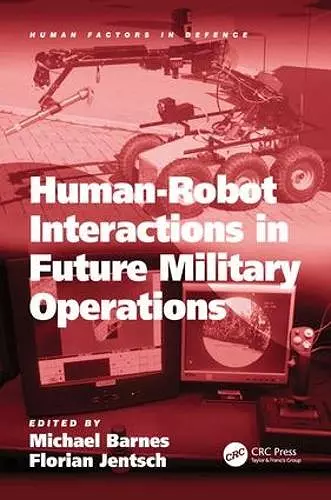Human-Robot Interactions in Future Military Operations
Florian Jentsch author Michael Barnes editor
Format:Hardback
Publisher:Taylor & Francis Ltd
Published:28th Jul '10
Currently unavailable, and unfortunately no date known when it will be back
This hardback is available in another edition too:
- Paperback£76.99(9781138071704)

Soldier-robot teams will be an important component of future battle spaces, creating a complex but potentially more survivable and effective combat force. The complexity of the battlefield of the future presents its own problems. The variety of robotic systems and the almost infinite number of possible military missions create a dilemma for researchers who wish to predict human-robot interactions (HRI) performance in future environments. Human-Robot Interactions in Future Military Operations provides an opportunity for scientists investigating military issues related to HRI to present their results cohesively within a single volume. The issues range from operators interacting with small ground robots and aerial vehicles to supervising large, near-autonomous vehicles capable of intelligent battlefield behaviors. The ability of the human to 'team' with intelligent unmanned systems in such environments is the focus of the volume. As such, chapters are written by recognized leaders within their disciplines and they discuss their research in the context of a broad-based approach. Therefore the book allows researchers from differing disciplines to be brought up to date on both theoretical and methodological issues surrounding human-robot interaction in military environments. The overall objective of this volume is to illuminate the challenges and potential solutions for military HRI through discussion of the many approaches that have been utilized in order to converge on a better understanding of this relatively complex concept. It should be noted that many of these issues will generalize to civilian applications as robotic technology matures. An important outcome is the focus on developing general human-robot teaming principles and guidelines to help both the human factors design and training community develop a better understanding of this nascent but revolutionary technology. Much of the research within the book is based on the Human Research and Engineering Directorate (HRED), U.S. Army Research Laboratory (ARL) 5-year Army Technology Objective (ATO) research program. The program addressed HRI and teaming for both aerial and ground robotic assets in conjunction with the U.S. Army Tank and Automotive Research and Development Center (TARDEC) and the Aviation and Missile Development Center (AMRDEC) The purpose of the program was to understand HRI issues in order to develop and evaluate technologies to improve HRI battlefield performance for Future Combat Systems (FCS). The work within this volume goes beyond the research results...
'This book is remarkable because it covers a variety of topics including fundamentals of human-robot interaction and research in ground and aerial platforms as well as cross platform. It provides a deep understanding of cognitive and social perspectives of human-robot teaming as well as strengths and limits of the two components: human and machine. Reviews on adaptive automation, telepresence, and multimodal interface technologies offer solutions to many issues in human-robot interaction: improving situation awareness and human-robot ratio as well as reducing soldier workload. Experience gained and lessons learned from both simulation and field studies provide insights of interaction issues associated with uninhabited systems: teaming, coordination, communication, asset management, and system performance. This volume is a must read for all researchers and developers concerned with human-robot teaming in military domain.' Ming Hou, Defence Research & Development, Canada 'Surprisingly, the more robots can do on their own, the more important becomes the ability to coordinate those activities with other people and groups. Barnes and Jentsch have assembled a comprehensive treatment of the latest data, concepts and interfaces needed to coordinate people and robots in demanding dynamic and uncertain situations.' David Woods, Ohio State University, USA ’...gives an insight into how ergonomics scientists are approaching questions in HRI, in conceptualising the problems, running experiments and exploring solutions. The book will thus be a useful addition to libraries in human factors.’ Australian Defence Force Journal, Issue No. 192, 2013
ISBN: 9780754675396
Dimensions: unknown
Weight: 975g
466 pages